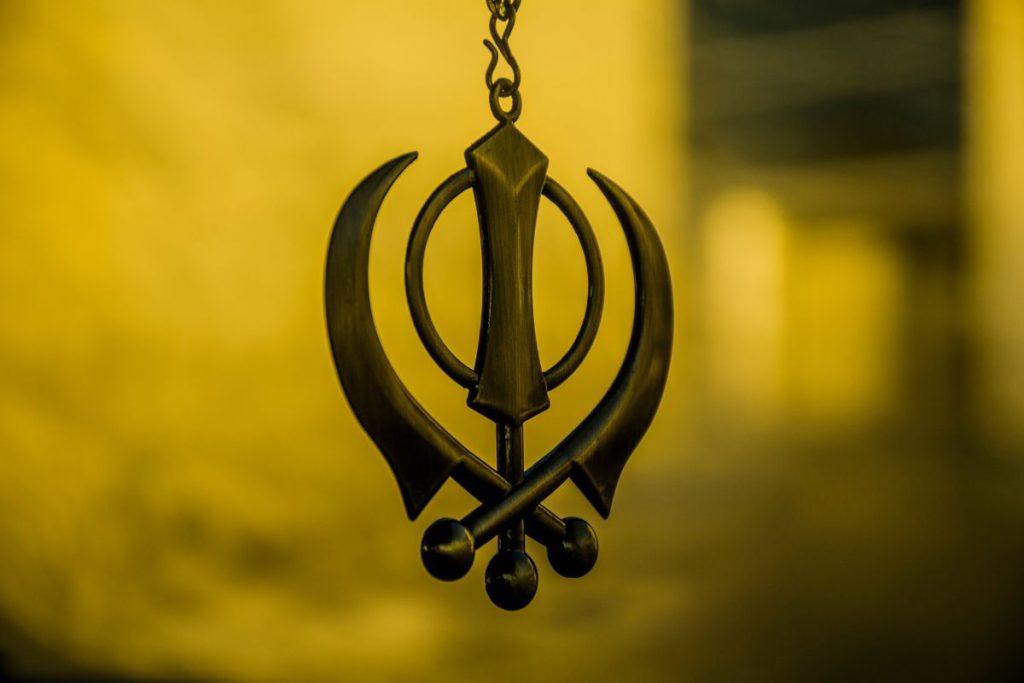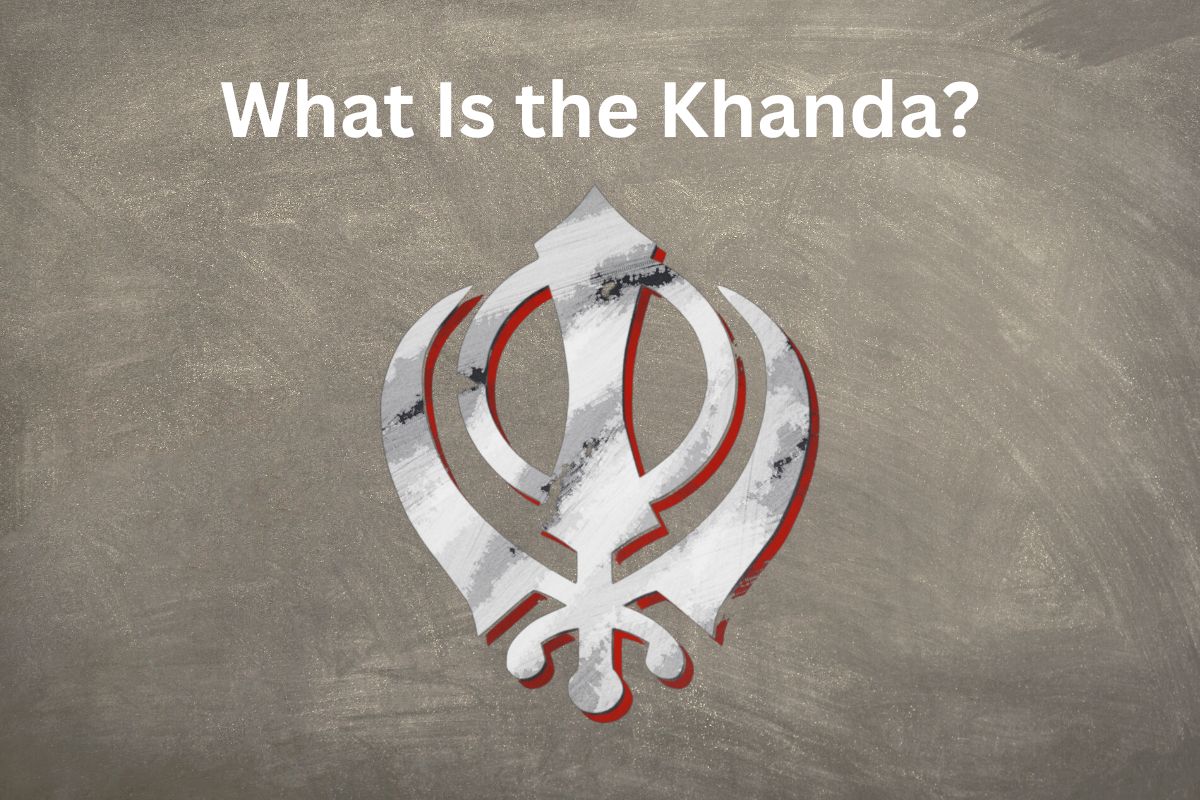The Khanda is a double-edged sword that is an important symbol in Sikhism. The Khanda is a symbol of truth, courage, and justice and is often associated with the qualities of the divine. In Sikh tradition, it's also related to Miri-Piri, which represents the balance between spiritual and temporal authority.
Sikhism is a monotheistic religion developed in the Indian subcontinent in the 15th century. It is depicted on the Sikh flag, known as the Nishan Sahib. It is also represented on the cover of the Guru Granth Sahib, the holy scripture of Sikhism.
What Does Khanda Mean?
The Khanda consists of three primary elements: a double-edged sword, a circular emblem, and two single-edged swords.
Double-edged Sword
The double-edged sword represents the divine knowledge and spiritual power of the Guru or teacher. It symbolizes righteousness and the ability to cut through ignorance and ego.
Circular Emblem
The circular emblem, known as the Chakkar, represents the unity and oneness of God. It symbolizes the soul’s eternal nature and the universe’s cyclical nature.
Single-Edged Swords
The two single-edged swords, known as the Miri Piri, represent the dual nature of the Sikh faith, combining both spiritual and temporal power.
The Khanda is a symbol of the principles of the Sikh faith, including righteousness, compassion, and justice. It’s also a symbol of the sovereignty of the Sikh people and their struggle for justice and equality.
The Khanda is an integral part of Sikh ceremonies and rituals. It is often displayed prominently in Sikh temples and places of worship. It symbolizes righteousness, compassion, and justice.

How Do You Pronounce Khanda?
Khanda is a Sanskrit term used in Hinduism and Sikhism and is pronounced Kuhn-duh. The stress is on the first syllable. The term khanda has its roots in the Sanskrit khaḍga or khaṅga, indicating to divide, break, destroy, or cut.
What Is the Significance of the Khanda?
The Khanda symbol reminds us that we’re all responsible for caring for those around us, regardless of race, color, or religion. It invites us to watch out for one another as an integration of the idea of one God, oneness in all creation, and balance between spiritual and secular authorities.
It’s a call to unity and kindness in which we treat one another with compassion and love. The Khanda symbol gains a more profound spiritual meaning when the idea of harmony between all things is considered.
The kirpans, or sacred daggers, Piri and Miri, respectively, symbolize the divine and human influences on the soul. The Khanda sword in the middle of the design stands for the capacity to see clearly and cut through deception. Expanded consciousness is possible.
The circle represents the harmony and integration of all things with the divine and the unity of all things. We are aware that we are infinite beings.
What Does the Symbol of the Sikh Khanda Symbolize?
The Khanda
Khanda is the prominent sword in the center of the khanda Sikh symbol, which denotes a belief in a single God. It can also represent the divine authority that governs all of life. The freedom one experiences when making morally sound decisions and abiding by the proper spiritual principles is symbolized by the right edge of the sword.
The left side of the Khanda symbolizes divine chastisement for those who commit wrongdoing and exercise cruel rule. The Khanda, as a whole, represents the separation of truth and lies.
A Chakram
The circle makes up the Khanda symbol’s overall design. It represents God’s eternal nature, which has no beginning or end. The chakra also represents the Sikh faith in the unity and oneness of all things.
There is no religious discrimination, and we are to be kind to one another. Sikhs also notice it as a reminder to follow God’s laws.
Dual Swords
The Piri sword, located to the left of the Khanda symbol, represents spiritual dominion. The Miri sword, on the right side, represents political authority.
All Sikhs are reminded that the Piri and Miri must maintain a balance between the spiritual and the material on each side of the closed chakra.

Why Do Sikhs Wear Khanda?
The symbol of Khanda symbolizes the Khalsa warrior code. Sikh warriors wear the Khanda pendant as a symbol of immortality. The Khanda icon represents these two ideas. It serves as the Sikhs’ military emblem. It is also incorporated into Nishan Sahib’s design.
Commonly, Khanda is used in home decor to instill Sikh faith in Punjabi houses. As it is a symbol of oneness or “ek onkar” or “ik onkar,” Sikhs wear the symbol “ਖੰਡਾ” to separate falsehood and truth.

What Is the Sikh Religion?
Sikhism is a monotheistic religion that developed in the Punjab region of India in the 15th century. It is based on the teachings of Guru Nanak and nine successive Gurus. The Guru Granth Sahib, the holy scripture of Sikhism, contains the teachings of the Gurus and other saints and scholars.
Sikhs believe in one supreme being, referred to as Waheguru, and the equality of all people. The core values of Sikhism include compassion, honesty, hard work, and humility. Sikhs are also required to follow a code of conduct known as the Rahit Maryada, which contains guidelines for living a spiritual life and practicing self-discipline.
Sikhs follow specific beliefs and practices that are important to their faith. These include wearing articles of faith, such as the turban and the kara (a steel bracelet), and participating in certain rituals, such as daily prayer and the Langar, a community meal in which all are welcome to partake.
Did you find this article on the Khanda helpful? Be sure to check out more great articles, like this one on the Cho Ku Rei symbol.

